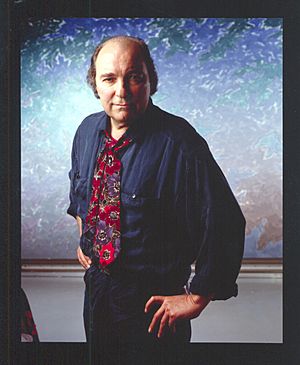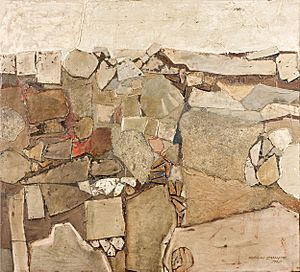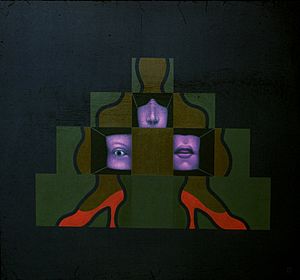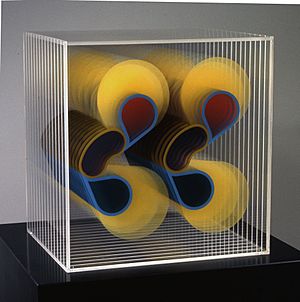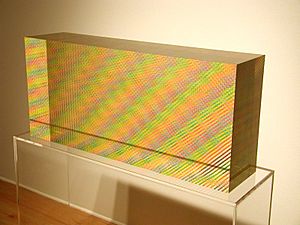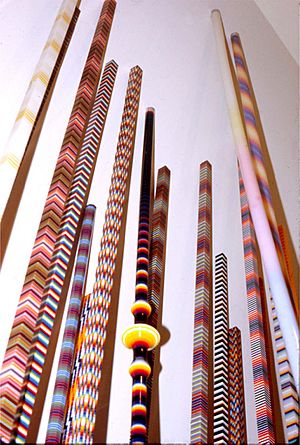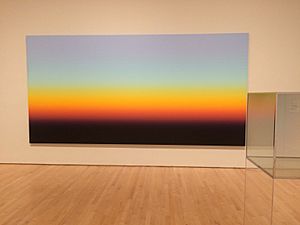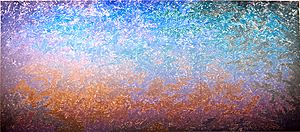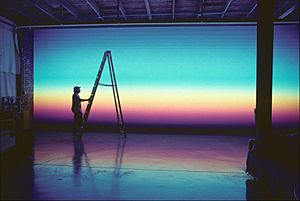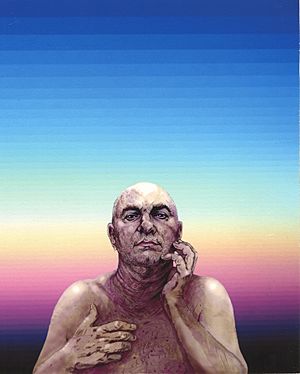Norman Zammitt facts for kids
Norman Charles Zammitt (February 3, 1931 – November 16, 2007) was an American artist. He was a leader in the Light and Space Movement in Southern California. In the 1960s, he created amazing transparent sculptures. Later, in the 1970s, he became known for his large, bright color paintings.
Contents
Early Life and Art Dreams
Norman Charles Zammitt was born in Toronto, Canada, on February 3, 1931. His mother was from the Iroquois Nation, and his father was Italian. His family moved a lot when he was young. They lived on the Kahnawake Reservation near Montreal. Then they moved to Montreal, Buffalo, and finally settled in Southern California when he was 14.
Norman loved drawing from a young age. When he was 12, he saw an oil painting by a Dutch artist. This made him even more excited about art. He also loved Disney films and drawing cartoon characters. He even created comic strips for his high school newspapers. His art skills won him many awards in high school.
After high school, he went to Pasadena City College. He was advised to study commercial art.
Art and Service
In 1952, the Korean War paused his education. Norman joined the Air Force as a photographer. He took aerial photos during his time in Korea. In his free time, he kept painting. He even painted a mural for an orphanage there. After returning to the U.S., he worked as a draftsman. In 1955, he married Marilyn Jean. They had two children, Dawn and Eric, who are both artists today.
After leaving the Air Force in 1956, Norman went back to college. He first studied commercial art but soon changed his mind. He wanted to study fine art. He got a scholarship to the Otis College of Art and Design. His teachers recognized his talent. One teacher, John Baldessari, said, "He was the best student. He could do anything." Norman earned his Master of Fine Arts degree in 1961.
Exploring Art Styles
Abstract Landscapes: Early Work
In 1960, Norman Zammitt joined the Felix Landau gallery in Los Angeles. This helped start his professional art career. His early works were small abstract pieces. He used oil paints, pencils, crayons, and other materials. Collectors really liked these artworks.
Bold Boxed Paintings: Human Forms
From 1962 to 1963, Zammitt created a series of paintings. These works showed parts of the human body. He placed them inside boxes against dark backgrounds. The paintings explored how human figures could be seen as fragments. Some people found these paintings surprising. They even caused a discussion about art censorship.
Clear Plastic Sculptures: Light and Space
While painting, Zammitt noticed how colors mixed on his glass palette. He was inspired by the bright light of New Mexico. This led him to create transparent sculptures. These were some of the first of their kind shown in Los Angeles and New York.
Layered Painted Artworks
From 1964 to 1966, he made "painted constructions." These were plastic boxes with clear plastic sheets inside. He painted abstract images on these sheets. The images seemed to change as you looked through the layers. This created a cool 3D effect.
Solid Light Creations
Later, from 1967 to 1969, he started laminating thicker plastic sheets. This made solid sculptures with layered images. Colors seemed to mix in space. Norman even invented new ways to cut and polish plastic. He shared his new methods with other artists.
Colorful Art Poles
Between 1970 and 1972, Zammitt made tall "poles." These sculptures were 8 to 10 feet long. They were made from solid colored acrylics. He arranged the colors in a specific order. Then he laminated and polished them. The final poles combined clear, see-through, and solid colors.
Paintings: Color and Math
Band Paintings: The Science of Color
After his sculptures, Zammitt returned to painting on canvas. He wanted to understand and show color itself. He felt that color had a deep, spiritual meaning. He often looked at the sky for inspiration. He didn't want to copy nature. Instead, he wanted to create the feeling of light with paint.
He noticed that existing color theories didn't quite match nature. So, he started mixing his own colors. He wanted to find the natural order of colors. He learned how one color could smoothly change into another.
Eventually, he couldn't just "eyeball" the colors anymore. He began using math, like logarithms and curves. This helped him measure and mix colors precisely. He could create smooth, unbroken color changes.
Norman even talked to mathematicians at the California Institute of Technology. They were very interested in his work. They found that his color progressions were like the growth rates of living things. This suggested that life itself might be connected to color. One art critic said his paintings were "magic" and pushed color "into the realm of the spirit."
Fractal and Chaos Art
From 1988 to 1992, Zammitt explored chaos theory in his paintings. He still used his color ideas. But he applied colors in a more spontaneous way. This created shapes that looked like cracking or breaking space. The colors still followed a mathematical order. But their arrangement on the canvas was more free.
Elysium: A Walk-In Painting
Norman Zammitt called his project Elysium a "walk-in painting." He imagined it as a special room. The walls would be painted with colors that glow under ultraviolet light. It would be a completely dark, glowing environment. He wanted it to be a place for peace and thought. He created a model of one wall, which was 13 by 35 feet. He hoped to build the full Elysium someday.
Self-Portraits: Inner Feelings
Later in his life, Norman Zammitt had to leave his large studio. This meant he couldn't create huge artworks anymore. He started drawing self-portraits. Over seven years, he made about 200 of them. He used pens, ink, brushes, and pencils.
He said these portraits were "a very intimate exploration of the human condition." He used himself to show different emotions. He wanted to express the struggles and hopes of the human spirit. Some portraits were lighthearted, while others were very personal.
Awards and Recognition
- Tamarind Lithography Workshop, Fellowship, 1967
- John Simon Guggenheim Memorial Foundation, Fellowship, 1968
- Pollock-Krasner Foundation, Grant, 1991
- Los Angeles City Council Commendation, September 15, 2000
- Los Angeles City Council declared "Norman Zammitt Day" on September 16, 2000
Where to See His Art
Museums and Institutions
You can find Norman Zammitt's art in many famous places, including:
- Museum of Modern Art, New York City
- Joseph Hirshhorn Gallery of Art, Washington, D.C.
- National Gallery of Art, Washington, D.C.
- Norton Simon Museum, Pasadena, California
- San Francisco Museum of Modern Art, San Francisco, California
- Los Angeles County Museum of Art, Los Angeles, California
- Victoria and Albert Museum, London, England
- Seattle Art Museum, Seattle, Washington
Private Collections
His art is also owned by many private collectors, including:
- Richard Feynman Estate
- Norman Lear
- Truman Capote Estate
Images for kids


